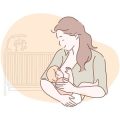1. Understanding the Importance of Nursing Bras
Breastfeeding is a beautiful and rewarding journey, but it also comes with its challenges. One essential item that can make this experience more comfortable and convenient is a well-fitting nursing bra. Designed specifically for breastfeeding moms, nursing bras provide the support, comfort, and ease of access needed during this special stage of motherhood.
Why Do You Need a Nursing Bra?
Unlike regular bras, nursing bras are designed to accommodate the changes in breast size and sensitivity that come with pregnancy and breastfeeding. They offer easy access for feeding or pumping while ensuring optimal support. Here are some key reasons why a nursing bra is an essential part of your maternity wardrobe:
| Benefit | Description |
|---|---|
| Comfort | Nursing bras are made from soft, stretchy materials that adapt to your changing body, preventing discomfort and irritation. |
| Support | Larger, fuller breasts during breastfeeding need extra support to reduce strain on your back and shoulders. |
| Convenience | Most nursing bras have clip-down or pull-aside cups for quick and easy breastfeeding access. |
| Flexibility | The design allows for fluctuations in breast size throughout the day as milk supply changes. |
How Nursing Bras Differ from Regular Bras
A common question many new moms ask is whether they can simply wear their regular bras while breastfeeding. While its possible, regular bras lack the features that make nursing easier and more comfortable. Here’s how nursing bras compare to standard bras:
| Feature | Nursing Bra | Regular Bra |
|---|---|---|
| Cup Access | Easily opens for feeding with clips or pull-aside design. | No built-in feature for breastfeeding access. |
| Fabric & Comfort | Softer, stretchier fabric to accommodate breast changes. | Tighter fit with less flexibility. |
| Support | Designed to support heavier, milk-filled breasts. | Might not provide adequate support for breastfeeding moms. |
| No Underwire Options | No underwire or flexible underwire to prevent clogged ducts. | Mainly structured with underwire, which can cause discomfort. |
The Right Time to Start Wearing a Nursing Bra
You may wonder when you should start shopping for nursing bras. Many women begin wearing them during pregnancy as their breasts grow and become more sensitive. Generally, it’s a good idea to have at least a couple of well-fitted nursing bras ready by the third trimester so youre prepared when your baby arrives.
Nursing Bra Essentials Every Mom Should Consider
- A good fit: Your bra should be snug but not too tight, allowing room for fluctuations in breast size.
- No underwire (or flexible underwire): Traditional underwires can put pressure on milk ducts, potentially leading to issues like clogged ducts or mastitis.
- Breathable fabric: Cotton or moisture-wicking materials help keep you comfortable throughout the day.
- Easily adjustable straps: Look for wide, cushioned straps that won’t dig into your shoulders.
- A secure but stretchy band: The band should offer firm support without being restrictive.
- User-friendly clasps: One-hand release clips make nursing much easier when holding your baby.
Nursing Bras Make Breastfeeding Easier and More Comfortable
The right nursing bra can make a significant difference in your breastfeeding experience. It provides necessary support, ensures convenience, and helps you feel comfortable throughout the day. Investing in quality nursing bras will help you focus more on bonding with your baby rather than dealing with discomfort from ill-fitting lingerie.
Now that we understand why nursing bras are essential, lets explore how to find the perfect fit in the next section!
2. How to Choose the Right Size
Finding the right size nursing bra is essential for comfort and support, especially as your body changes during pregnancy and breastfeeding. A well-fitted bra helps prevent discomfort, back pain, and clogged ducts. Below are expert tips on measuring yourself correctly and choosing the perfect fit.
How to Measure Yourself
To find your correct nursing bra size, follow these simple steps:
Step 1: Measure Your Band Size
Use a soft measuring tape and wrap it around your ribcage, just under your bust. Make sure the tape is snug but not too tight. Round up to the nearest even number to determine your band size.
Step 2: Measure Your Bust Size
Wrap the measuring tape around the fullest part of your breasts, keeping it level across your back. Ensure its comfortably snug but not squeezing.
Step 3: Calculate Your Cup Size
Subtract your band size from your bust measurement. Use the difference to determine your cup size using the table below:
| Difference (in inches) | Cup Size |
|---|---|
| 1″ | A |
| 2″ | B |
| 3″ | C |
| 4″ | D |
| 5″ | DD/E |
| 6″ | DDD/F |
Nursing Bra Fit Tips
- Your nursing bra should feel snug but not restrictive.
- The band should sit flat against your body without riding up in the back.
- The cups should fully cover your breasts without spilling over or gaping.
- You should be able to fit two fingers under the straps for comfort.
- A bra with adjustable closures allows room for fluctuations in breast size.
Sizing Considerations During Pregnancy & Nursing
Your breast size will likely change throughout pregnancy and breastfeeding. Its best to measure yourself every few months and choose bras with some flexibility in sizing, such as those with stretchy fabric or multiple hook-and-eye closures.
Selecting the right nursing bra ensures you stay comfortable while providing the support you need during this special time in your life.

3. Types of Nursing Bras and Their Benefits
Finding the right nursing bra can make breastfeeding more comfortable and convenient. There are several types of nursing bras designed to meet different needs, whether youre looking for extra support, nighttime comfort, or hands-free pumping. Below, we explore some of the most popular styles and their benefits.
Wireless Nursing Bras
Wireless nursing bras provide gentle support without an underwire, making them a great option for everyday wear. They help prevent clogged ducts and discomfort while still offering enough structure for light to moderate support.
Benefits:
- Comfortable for all-day wear
- Reduces pressure on breast tissue
- Ideal for preventing irritation and clogged ducts
Underwire Nursing Bras
If you prefer more structured support, underwire nursing bras provide lift and shape. However, its important to ensure the underwire does not press against breast tissue, which could lead to discomfort or clogged milk ducts.
Benefits:
- Provides extra support for larger breasts
- Keeps breast shape well-defined under clothing
- A good option for work or formal occasions
Sleep Nursing Bras
A sleep nursing bra is designed for nighttime comfort with a soft, stretchable fabric that allows easy access for feeding. These bras often have a crossover design that makes night feedings easier.
Benefits:
- Lightweight and ultra-soft material for maximum comfort
- No clasps or hooks for easy nighttime access
- Keeps nursing pads in place to prevent leaks overnight
Hands-Free Pumping Bras
Pumping can be time-consuming, but a hands-free pumping bra allows you to multitask while expressing milk. These bras securely hold pump flanges in place so you don’t have to keep your hands on them.
Benefits:
- Makes pumping sessions more efficient
- Keeps bottles stable to prevent spills
- Ideal for working moms or exclusive pumpers
Nursing Bra Comparison Table
| Nursing Bra Type | Main Benefit | Best For |
|---|---|---|
| Wireless Nursing Bra | No underwire, prevents discomfort and clogged ducts | Everyday wear, comfort-focused moms |
| Underwire Nursing Bra | Adds structure and support for larger breasts | Moms who need extra lift and shaping |
| Sleep Nursing Bra | Softer fabric with no clasps for nighttime use | Nursing at night, keeping nursing pads in place |
| Hands-Free Pumping Bra | Keeps pump flanges secure for hands-free pumping | Pumping moms who need convenience while multitasking |
4. Features to Look for in a Nursing Bra
Finding the right nursing bra is about more than just size—it’s also about comfort, convenience, and support. Here are some key features to look for when choosing a nursing bra that will make breastfeeding easier and more comfortable.
Adjustable Straps
Nursing bras with adjustable straps allow you to customize the fit as your body changes during pregnancy and postpartum. Look for wide, padded straps to help distribute weight evenly and prevent shoulder discomfort.
Clip-Down Cups
One of the most essential features of a nursing bra is clip-down or drop-down cups. These allow for easy one-handed access when breastfeeding or pumping, making feeding more convenient, especially in public or during nighttime feedings.
Breathable Fabrics
Your skin may be more sensitive during this time, so breathable fabrics like cotton or moisture-wicking blends can help keep you cool and comfortable. Avoid materials that may cause irritation or trap heat.
Extra Support Elements
A good nursing bra should provide enough support without feeling restrictive. Consider features such as:
| Feature | Benefit |
|---|---|
| Wide Bands | Provides better back support and reduces strain on shoulders. |
| Molded Cups | Adds shape and prevents leaks from showing through clothes. |
| No Underwire (or Flexible Underwire) | Avoids discomfort while still offering structure and lift. |
Easily Washable & Durable
Nursing bras should withstand frequent washing since leaks and spills are common. Look for machine-washable options made from durable fabrics that maintain their shape over time.
5. Caring for Your Nursing Bras
Taking care of your nursing bras properly will help them last longer and maintain their shape and support throughout your breastfeeding journey. Here are some simple yet effective tips on washing, storing, and maintaining your nursing bras.
Washing Your Nursing Bras
Since nursing bras are worn frequently, its important to clean them properly to extend their lifespan. Follow these washing guidelines:
| Washing Method | Instructions |
|---|---|
| Hand Wash (Recommended) | Use lukewarm water and a mild detergent. Gently rub the fabric and rinse thoroughly. Avoid wringing the bra as it can damage the elastic fibers. |
| Machine Wash | If using a washing machine, place bras in a mesh laundry bag to prevent stretching. Use a gentle cycle with cold water and a mild detergent. |
Drying Your Nursing Bras
Avoid using a dryer as heat can break down elastic fibers and weaken the fabric. Instead:
- Lay Flat to Dry: Place the bra on a clean towel to maintain its shape.
- Avoid Hanging by Straps: This can stretch out the elastic and distort the fit.
- No Direct Sunlight: Too much heat exposure can fade colors and weaken fabric fibers.
Storing Your Nursing Bras
The way you store your nursing bras can also impact their durability. Follow these storage tips:
- Avoid Folding Cups: Instead, stack bras in a drawer with cups facing up to maintain their shape.
- No Overcrowding: Give your bras space so they don’t get crushed or misshapen.
- Keeps Hooks Fastened: This prevents snagging on delicate fabrics.
When to Replace Your Nursing Bras
Nursing bras go through a lot of wear and tear, so knowing when to replace them is essential for continued comfort and support. Signs that its time for a new one include:
- Losing Elasticity: If the band or straps feel loose and don’t provide enough support.
- Cup Shape Changes: When cups become stretched out or wrinkled.
- Irritation or Discomfort: If the fabric feels rough or causes skin irritation.
Taking proper care of your nursing bras ensures they stay comfortable, supportive, and durable throughout your breastfeeding journey. With these simple maintenance tips, you can keep your favorite nursing bras in great condition for as long as possible!


